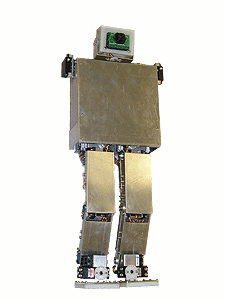|
|
RO-PE II (click here for it walking video)
Specifications
|
Degree Of Freedoms:
Height:
Width:
Weight:
Armor materials:
Sensors:
|
18
495mm
150mm
2.5kg
0.5mm Aluminium (Al) plate
Infra-red x 2
Force x 8
Vision x 1
Tilt x 1
Gyro x 1
Accelerometer x 1 |
Control System
The performance of a biped directly depends on the control system. If the control system is not sufficient, no matter how good is the control algorithm, the biped may not have desired performance. However, the power of a control system is usually inversely proportional to its size.
We need to built a powerful control system but within space limit of the application.
The control system used in ROPE-II consists of computer system, sensors and actuators. Followings is a diagram illustrating connection among various elements of the control system.
|

(Top) ROPE II standing tall and strong |
|

(Top) The building of ROPE II requires the integration of sensor systems |
Computer Systems
PC-104: This is really a normal Personal Computer with compact size suitable for mobile application.
DAQ card: The card we are using is DMM32AT of Diamond System. This DAQ card is used to read analog signals from the sensors.
Basic Stamp: This is a microcontroller which is built from popular PIC chip family. Basic Stamp receives position commands from PC-104 and generate PWM signals to control the servos
Operating system: RTLinux is the operating system of choice. Among the advanges of using this OS are its free distribution and real-time behavior. Its performance is so great.
Sensors
There are several sensors needed for the biped to walk stably. These include:
Force sensor: Force sensors are used to sense the center of pressure on the feet sole. We are using FlexiForce with measurement range of 25lbs.
Tilt sensor: This dual axis tilt sensor is used to sense the tilt angles of the body. This is a product of Crossbow.
Accelerometer: The 3-axis accelerometer in use is also a product of Crossbow. It is used to sense the acceleration of the robot.
Gyro: This sensor of Silicon Sensing System is used to sense the direction in which the biped is heading.
Camera: This is the vision sensor of the robot. We are using CMUCam which is a low cost yet powerful camera.
Actuators
Actuators are also a very important element of a biped. A perfect actuator should be a light-weight yet high-torque motor. We have found that servo motors, which are used extensively in hobby airplane, are very suitable for this application.
Initially we used Futaba motor, but it is not strong enough with a stall torque of 8 kg/cm. We are now using Hitec motor with torque up to 13 kg/cm. That means we can hang a 13 kg object at the arm length 1cm!
Control Algorithms
To have a good control system is just half of the solution. A robust control algorithm is the other half. Several control algorithms have been studied and simulated to find a suitable algorithm for this robot. Among the algorithms of studying are static walking, virtual model control, linear inverted pendulum, ZMP trajectory planning.
Some simulations can be found in the movie clips section. With the solid background gaining from studying existing algorithms, we will develop a new algorithm suitable for this biped.
|
